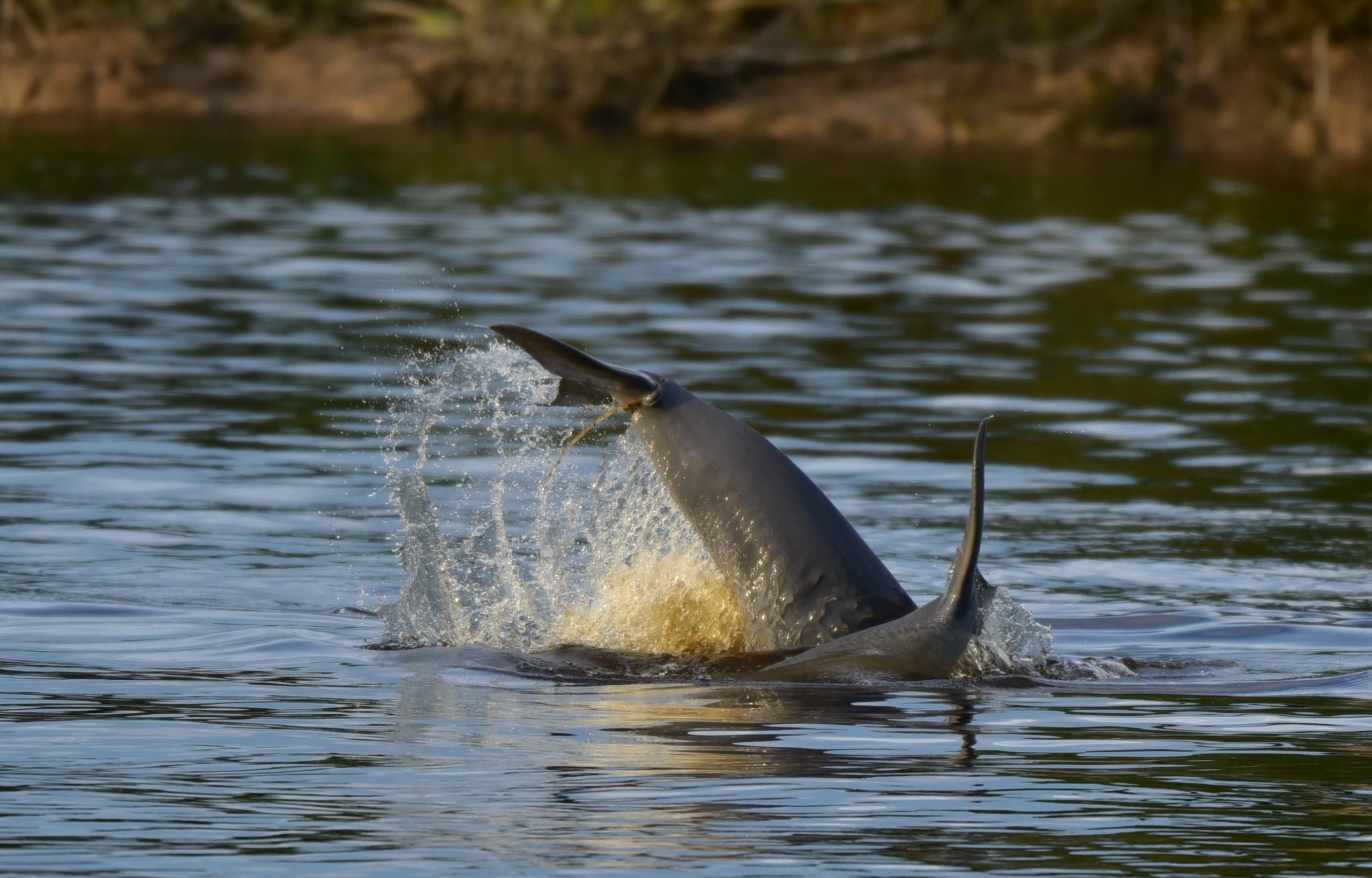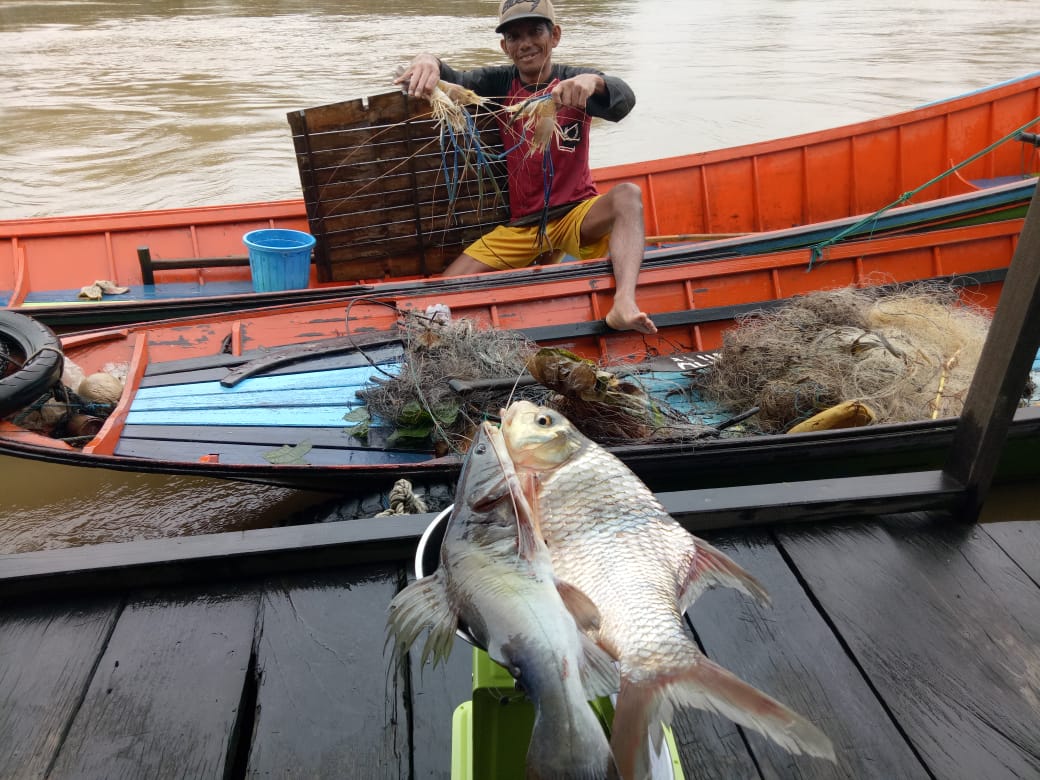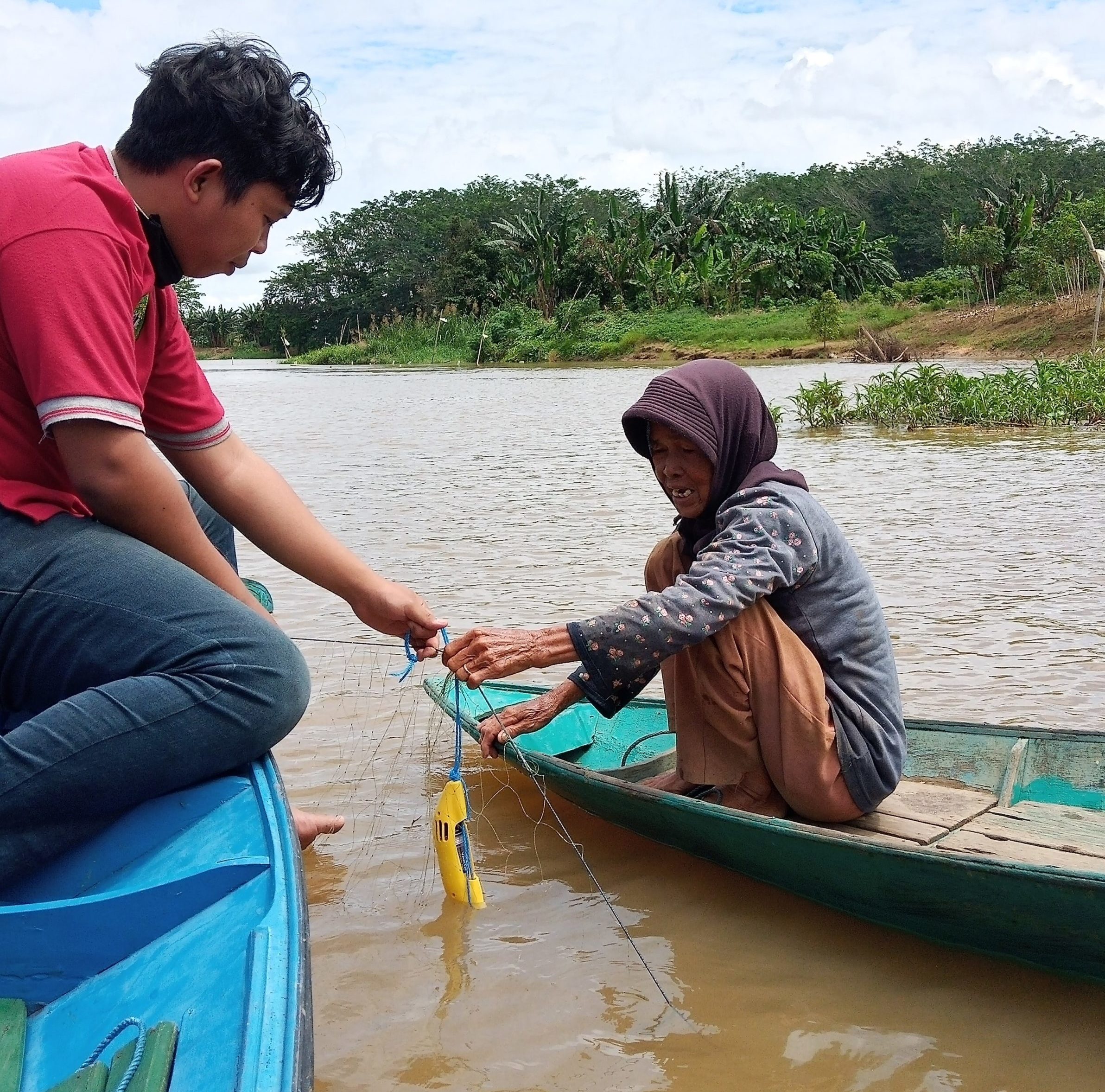- A trial has demonstrated that underwater acoustic pingers can keep river dolphins at a safe distance from fishing nets, preventing fatal entanglements.
- Fishers in the Mahakam River in Indonesian Borneo collaborated with researchers to test the devices that emit a high-frequency sound that acts as a deterrent to the local population of freshwater Irrawaddy dolphins.
- Aside from protecting the dolphins, the devices were also found to increase fishers’ catches and reduce costly repairs to nets; experts describe this as a “win-win” solution.
- International river dolphin initiatives are now testing the devices in locations such as the Amazon, the Ganges and the Indus rivers to find out if they can be implemented at a much larger scale to safeguard dwindling river dolphin species worldwide.
The last 80 Irrawaddy dolphins that inhabit the Mahakam River in Indonesian Borneo lead precarious lives. Their forays to find fish are frequently thwarted, sometimes fatally so, by a series of near-invisible gillnets that hang passively in the water column to ensnare fish. More than two-thirds of recorded river dolphin deaths in the Mahakam are due to entanglement in these fishing nets.
At an average of four deaths per year, experts say the losses are unsustainable for this critically endangered population of Irrawaddy dolphins (Orcaella brevirostris). Each dolphin drowned in a net nudges the population one step closer toward extinction.
But their fate is not yet sealed. Over the past two years, local fishers have collaborated with the nonprofit Conservation Foundation for Rare Aquatic Species of Indonesia (YK-RASI) to develop an innovative solution to the dolphins’ plight. By attaching a banana-sized electronic device called a “pinger” to their nets, fishers have found they are able to keep the dolphins at a safe distance, preventing fatal entanglements.
Pingers emit regular high-frequency pulses that are sufficiently audible to dolphins to serve as a deterrent. While pingers have been used around the world to reduce ocean bycatch of whales, dolphins and porpoises, this is the first time they have been used successfully in a river.
The team assessed the pingers’ efficacy using underwater acoustic recorders to listen to the dolphins’ echolocation clicks and observations of the animals’ behavior from the surface. Their data indicated that dolphins kept a 10-meter (33-foot) radius around the pingers, according to Danielle Kreb, scientific program manager for YK-RASI.
“I’ve seen them chasing a fish and you could see the fish jumping toward the point where the pinger was and then the dolphin would just back off, it would not pursue the fish,” Kreb told Mongabay.
Aside from protecting the dolphins, the breakthrough also heralds a respite for the Mahakam’s fishing community, whose diet and livelihoods depend on river fish. The dolphins are much revered in local folklore, so it’s an ordeal for fishers to find dolphins in their nets. Moreover, keeping dolphins away from their catch reduces net repair costs and improves catches.
Over the course of six months in 2020, the team found that fishers generally caught more and larger fish when the pinger was on. Kreb said this has led to widespread acceptance of the pingers, with many more fishers keen to join the project.


A trade-off but an immediate solution
Notwithstanding their success, questions have been raised over the long-term use of pingers. A particular concern is habituation — that dolphins will learn to ignore them over time.
“It is possible that, if cetaceans are using such nets as a source of food, that they may learn to ignore, or even become attracted to pingers on nets,” Simon Northridge, a marine mammal biologist at the University of St. Andrews in the U.K., told Mongabay in an email. “[But] the possibility does not detract from their usefulness now. It would be foolish not to use pingers just in case they might not work in the future, though it would also be wise to continue to monitor their effectiveness.”
Kreb said the pingers used in the Mahakam modulate between frequencies of 50 and 120 kilohertz to avoid habituation. She added researchers also periodically monitor the dolphins’ behavior through surveys and discourse with fishers.
Kreb shared Northridge’s sense of urgency that tools that can reduce dolphin deaths immediately should be implemented. “We should not wait until the dolphins die, we should do something right now and stop them dying first and look for long-term solutions as well,” she said.
Another concern is that the sound emitted by the pingers could exacerbate the already noisy underwater environment and stress dolphins into abandoning important feeding grounds. Underwater noise is also considered a possible cause of marine mammal strandings that are a widespread problem in Indonesia.
Kreb said noise pollution from ship traffic is already a major problem in the Mahakam, so fine-tuning the pingers to function well at the lowest possible volume was a priority. The researchers noticed that dolphins continued to snoop around the nets when pingers were set to 100 decibels, but they found a sweet spot at 125 dB, which kept dolphins away from the nets while allowing them to continue feeding and behaving naturally nearby.
Ultimately, pingers are a trade-off between reducing entanglement deaths and increased underwater noise. Kreb said the pingers are an ideal interim solution in the Mahakam until alternative dolphin-safe fishing methods can be developed and implemented alongside wider habitat protection of the dolphins’ core habitat in the middle reaches of the river.

Pingers can bend the curve
Unusually, Irrawaddy dolphins are found in both freshwater and marine environments, with the majority of the species distributed in coastal waters across southeastern Asia. None of the species’ three freshwater populations — found in the Mahakam, the Mekong and the Irrawaddy rivers — have more than 100 individuals.
The outlook for the Mekong population of Irrawaddy dolphins is particularly uncertain. Diminishing water levels in the main river due to upstream dams restrict the dolphins to a series of deep pools in Cambodia, increasing their risk of isolation and extinction. In fact, subpopulations have already begun to succumb: surveys in 2021 found only one dolphin remains of a group that once lived in water spanning the border between Cambodia and Laos.
Daphne Willems, who leads WWF’s river dolphin initiative that part-funded the Mahakam pinger project, said the transboundary subpopulation’s demise serves as a wake-up call for efforts to protect all six species of river dolphins around the world, all of which are in decline.
Willems said the success of the Mahakam pinger trial provides much-needed hope, and that deploying the technology in other river systems that support dolphin populations could be a “win-win” solution. “Thousands of river dolphins die in gillnets every year. I truly feel that if we can tackle the gillnet mortality then we can bend the curve … it can save so many lives,” she said.
In the Mahakam, Willems said she would like to make sure that every fisher using a gillnet also has a pinger. “It would be game-changing for that population,” she said.
Willems and her team are now trialing pingers in Pakistan, Peru and Brazil to find out whether species like the Indus river dolphin (Platanista gangetica minor) and the Amazon river dolphin (Inia geoffrensis) respond in a similar way. The primary objective is to reduce gillnet entanglements, but in the Indus and Ganges river systems, pingers could also prevent dolphins from entering shallow irrigation canals where they frequently become stranded.
Nonetheless, the sheer size of the Amazon and the Ganges means that rolling out pingers at a scale that will have meaningful impact for the dolphins becomes a question of funding, Willems said.
“A single pinger is not that expensive, but you will need millions of them to cover the Amazon or Ganges and you need to keep monitoring them,” Willems said. “So we’re not done yet, but we have a plan and a route on how to make this work worldwide.”
Banner image: A freshwater Irrawaddy dolphin surfaces in the Mahakam River. Image © S Kedang Rantau-Budiono/Yayasan Konservasi RASI
FEEDBACK: Use this form to send a message to the author of this post. If you want to post a public comment, you can do that at the bottom of the page.
